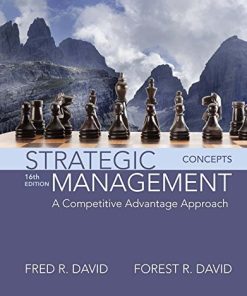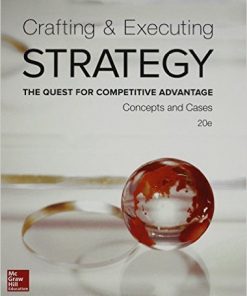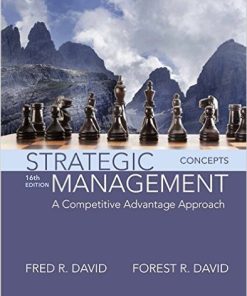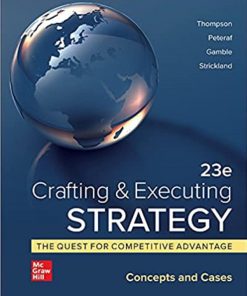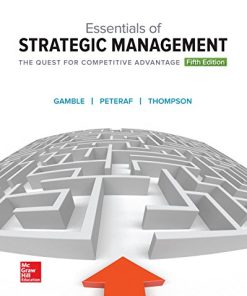(EBook PDF) Strategic Management A Competitive Advantage Approach, Concepts and Cases 17th Edition Fred David, Forest David, Meredith David 9781292745640 full chapters
$50.00 Original price was: $50.00.$25.00Current price is: $25.00.
Strategic Management: A Competitive Advantage Approach, Concepts and Cases 17th Edition Fred R. David, Forest R. David, Meredith E. David 9781292745640 – Ebook PDF Instant Download/DeliveryISBN:
Full download Strategic Management: A Competitive Advantage Approach, Concepts and Cases 17th Edition after payment.
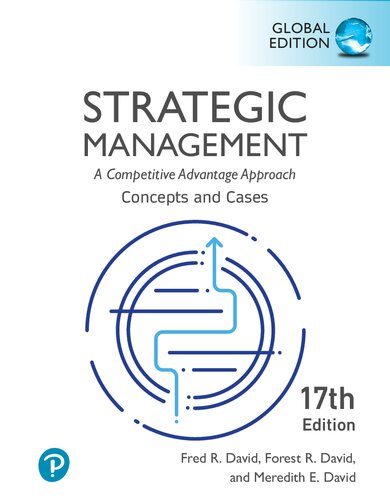
Product details:
ISBN-13 : 9781292745640
Author: Fred R. David, Forest R. David, Meredith E. David
Strategic Management: A Competitive Advantage Approach, Concepts and Cases [RENTAL EDITION]
Strategic Management: A Competitive Advantage Approach, Concepts and Cases 17th Table of contents:
Part 1 Overview of Strategic Management
1 The Nature of Strategic Management
Learning Objectives
Assurance-of-Learning Exercises
What Is Strategic Management?
Strategic Planning
The Strategic-Management Model
Stages of Strategic Management
Integrating Analysis and Intuition
Adapting to Change
Key Terms in Strategic Management
Competitive Advantage
Strategists
Vision and Mission Statements
External Opportunities and Threats
Internal Strengths and Weaknesses
Long-Term Objectives
Strategies
SWOT Analysis
Annual Objectives
Policies
Benefits of Engaging in Strategic Management
Financial Benefits
Nonfinancial Benefits
Why Some Firms Do No Strategic Planning
Pitfalls in Strategic Planning
Comparing Business and Military Strategies
Developing Employability Skills
Chapter Summary
Key Terms and Concepts
Issues for Review and Discussion
Web Resources
Current Readings
Endnotes
Part 2 Strategy Formulation
2 Business Vision and Mission
Learning Objectives
Assurance-of-Learning Exercises
Core Values Statements: What Is Our Foundation?
Vision Statements: What Do We Want to Become?
Characteristics of a Vision Statement
Vision Statement Analysis
Mission Statements: What Is Our Business?
Characteristics of a Mission Statement
Components of a Mission Statement
The Importance (Benefits) of Vision and Mission Statements
The Process of Developing Vision and Mission Statements
Evaluating and Writing Mission Statements
Chapter Summary
Key Terms and Concepts
Issues for Review and Discussion
Web Resources
Current Readings
Endnotes
3 The External Assessment
Learning Objectives
Assurance-of-Learning Exercises
The External Assessment Phase of Strategy Formulation
Key External Forces
The Actionable-Quantitative-Comparative-Divisional (AQCD) Test
10 External Forces that Impact Organizations
Economic Forces
Social, Cultural, Demographic, and Environment (SCDE) Forces
Political, Governmental, and Legal Forces
Technological Forces
Competitive Forces
Porter’s Five-Forces Model
Rivalry Among Competing Firms
Potential Entry of New Competitors
Potential Development of Substitute Products
Bargaining Power of Suppliers
Bargaining Power of Consumers
Key Sources of Information for an External Audit
Forecasting and Making Assumptions
Making Assumptions
The External Factor Evaluation Matrix
Steps to Develop an EFE Matrix
Step 1: Develop a Full and Narrow List of Key External Factors
Step 2: Assign Weights to Key External Factors
Step 3: Assign Ratings to Key External Factors
Step 4: Obtain Weighted Scores
Step 5: Obtain Total Weighted Score
An Example EFE Matrix
The Competitive Profile Matrix
Chapter Summary
Key Terms and Concepts
Issues for Review and Discussion
Web Resources
Current Readings
Endnotes
4 The Internal Assessment
Learning Objectives
Assurance-of-Learning Exercises
The Internal Assessment Phase of Strategy Formulation
Resource-Based View
Key Internal Forces
Management
Planning
Organizing
Motivating
Controlling
Integrating Strategy and Culture
Management Audit Checklist of Questions
Marketing
Marketing Research and Target Market Analysis
Product Planning
Pricing
Promotion
Channels of Distribution
Marketing Audit Checklist of Questions
Finance and Accounting
Finance and Accounting
Financial Ratios
Finance and Accounting Audit Checklist
Management Information Systems
Business Analytics
The Internal Factor Evaluation (IFE) Matrix
The Actionable-Quantitative-Comparative-Divisional (AQCD) Test
Steps in Developing an IFE Matrix
Step 1: Develop a Full and Narrow List of Key Internal Factors
Step 2: Assign Weights to Key Internal Factors
Step 3: Assign Ratings to Key Internal Factors
Step 4: Obtain Weighted Scores
Step 5: Obtain Total Weighted Score
An Example IFE Matrix
Chapter Summary
Key Terms and Concepts
Issues for Review and Discussion
Web Resources
Current Readings
Endnotes
5 Strategies in Action
Learning Objectives
Assurance-of-Learning Exercises
Long-Term Objectives
Characteristics and Benefits of Objectives
Financial versus Strategic Objectives
Avoid Managing by Crisis, Hope, Extrapolation, and Mystery (CHEM)
Types of Strategies
Levels of Strategies
Integration Strategies
Forward Integration
Backward Integration
Horizontal Integration
Intensive Strategies
Market Penetration
Market Development
Product Development
Diversification Strategies
Related Diversification
Unrelated Diversification
Defensive Strategies
Retrenchment
Divestiture
Liquidation
Value Chain Analysis and Benchmarking
Benchmarking
Michael Porter’s Two Generic Strategies
Cost Leadership
Differentiation
Means for Achieving Strategies
BUILD from Within to Grow
BORROW from Others to Grow
BUY Others to Grow
First-Mover Advantages
Strategic Management in Nonprofit and Small Firms
Educational Institutions
Governmental Agencies and Departments
Small Firms
Chapter Summary
Key Terms and Concepts
Issues for Review and Discussion
Web Resources
Current Readings
Endnotes
6 Strategy Analysis and Choice
Learning Objectives
Assurance-of-Learning Exercises
Strategy Analysis and Choice
The Process of Generating and Selecting Strategies
The Strategy-Formulation Analytical Framework
Stage 1: The Input Stage
Stage 2: The Matching Stage
Stage 3: The Decision Stage
The SWOT Matrix
The Strategic Position and Action Evaluation (SPACE) Matrix
Steps in Performing SPACE Analysis
SPACE Matrix Quadrants
SPACE Matrix
The Boston Consulting Group (BCG) Matrix
The Internal-External (IE) Matrix
The Grand Strategy Matrix
The Decision Stage: The QSPM
Positive Features and Limitations of the QSPM
How to Estimate Costs Associated with Recommendations
Cultural Aspects of Strategy Analysis and Choice
The Politics of Strategy Analysis and Choice
Chapter Summary
Key Terms and Concepts
Issues for Review and Discussion
Web Resources
Current Readings
Endnotes
Part 3 Strategy Implementation
7 Implementing Strategies: Management and Marketing Issues
Learning Objectives
Assurance-of-Learning Exercises
Transitioning from Formulating to Implementing Strategies
The Need for Clear Annual Objectives
Establish Policies
Allocate Resources and Manage Conflict
Allocate Resources
Manage Conflict
Match Structure with Strategy
Types of Organizational Structure
The Functional Structure
The Divisional Structure
The Strategic Business Unit Structure
The Matrix Structure
Do’s and Don’ts in Developing Organizational Charts
How to Depict an Organizational Chart
Strategic Production/Operations Issues
Restructuring and Reengineering
Manage Resistance to Change
Decide Where and How to Produce Goods
Strategic Human Resource Issues
Link Performance and Pay to Strategy
Balance Work Life and Home Life
Promote Diversity
Use Caution in Hiring a Rival’s Employees
Create a Strategy-Supportive Culture
Use Caution in Monitoring Employees’ Social Media
Develop a Corporate Well-Being Program
Strategic Marketing Issues
Segment and Target Markets Effectively
Product Positioning
Perceptual Mapping
Engage Customers in Social Media
Chapter Summary
Key Terms and Concepts
Issues for Review and Discussion
Web Resources
Current Readings
Endnotes
8 Implementing Strategies: Finance and Accounting Issues
Learning Objectives
Assurance-of-Learning Exercises
Capital Structure
EPS/EBIT Analysis: Steps to Complete
EPS/EBIT Analysis: An Example
EPS/EBIT Analysis: Limitations
Projected Financial Statements
The Free Excel Strategic Planning Template at www.strategyclub.com
Steps to Develop Projected Financial Statements
Nonprofit Organizations
P&G’s Actual Financial Statements
P&G’s Projected Financial Statements
P&G’s Retained Earnings Data Table
Corporate Valuation
Corporate Valuation Methods
Method 1
Method 2
Method 3
Method 4
Manage Financial Ratios, IPOs, and Bonds
Financial Ratio Analyses
Go Public with an IPO?
Issue Bonds to Raise Capital?
Chapter Summary
Key Terms and Concepts
Issues for Review and Discussion
Web Resources
Current Readings
Part 4 Strategy Evaluation and Governance
9 Strategy Evaluation and Governance
Learning Objectives
Assurance-of-Learning Exercises
The Strategy-Evaluation Process
Three Strategy-Evaluation Activities
Reviewing Bases of Strategy
Measuring Organizational Performance
Taking Corrective Actions
The Balanced Scorecard
Boards of Directors: Governance Issues
Challenges in Strategic Management
The Art or Science Issue
The Visible or Hidden Issue
Promote Workplace Democracy
Contingency Planning
Auditing
Guidelines for Effective Strategic Management
Chapter Summary
Key Terms and Concepts
Issues for Review and Discussion
Web Resources
Current Readings
Endnotes
People also search for Strategic Management: A Competitive Advantage Approach, Concepts and Cases 17th:
strategic management a competitive advantage approach 17th edition
strategic management a competitive advantage approach 18th edition
strategic management a competitive advantage approach 18th
strategic management a competitive advantage approach concepts
strategic management a competitive advantage approach concepts and cases
Tags:
Strategic Management,Competitive Advantage,Approach,Concepts,Cases,Fred David,Forest David,Meredith David
You may also like…
Uncategorized
Strategic Management: A Competitive Advantage Approach, Concepts 16th Edition, (Ebook PDF)
Uncategorized
Business & Economics - Human Resources
Strategic Human Resource Management: Gaining a Competitive Advantage
Uncategorized
Business & Economics - Econometrics
Crafting & Executing Strategy: The Quest for Competitive Advantage: Concepts and Cases 23rd Edition
Business & Economics - Management & Leadership
Strategic Management : A Competitive Advantage Approach — Concepts and Cases, 17th Global Edition
Uncategorized
Essentials of Strategic Management: The Quest for Competitive Advantage 5th Edition, (Ebook PDF)





